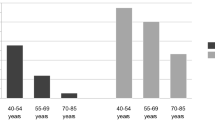Abstract
This paper examines the digital divide in Internet use in later life. We hypothesise that the differential diffusion of domestic information and communication technologies between pre- and post-Second World War cohorts is primarily responsible for this divide rather than either age-associated structural inequalities or age-related intrinsic features of mental and/or physical infirmity. Using data from the English Longitudinal Study of Ageing we show that age/cohort differences in Internet use persist after income, education, employment and health status are controlled for. However, when engagement with domestic information and communication technology and cultural activities are taken into account, age/cohort influences on Internet use decline. These contingent ‘age/cohort’ effects suggest that ‘generational’ rather than ‘structural’ or ‘stage of life’ influences may be more salient explanations of the (age-based) digital divide.

Similar content being viewed by others
References
Akhter SH (2003) Digital divide and purchase intention: why demographic psychology matters. J Econ Psychol 24:321–327
Axa Retirement Scope 2007a. Retirement, a new life after work? Results for Netherlands, with international comparisons, Wave 3. http://www.retirement-scope.axa.com/country/download/2007/retirement_scope_nl_en.pdf (accessed February 25th, 2007)
Axa Retirement Scope 2007b. Retirement, a new life after work? Results for Germany with international comparisons, Wave 3. http://www.retirement-scope.axa.com/country/download/2007/retirement_scope_germany_en.pdf (accessed, March 21st, 2007)
Bajekal M, Primatesta P, Prior G (eds) (2003) Health survey for England 2001. Methodology & Documentation, The Stationery Office, London
Bucy EP (2000) Social access to the Internet. Harvard International Journal of Press/Politics 5:50–61
Castells M (1996) The rise of the network society. Blackwell, Oxford
Chakraburty J, Bosman MM (2005) Measuring the digital divide in the United States: race, income and personal computer ownership. Prof Geogr 57:395–410
Chaudhuri A, Flamm K, Horrigan J (2005) An analysis of the determinants of Internet access. Telecomm Policy 29:731–755
Compaine BM (2001) The digital divide: facing a crisis or creating a myth?. MIT Press, Cambridge
Cutler SJ, Hendricks J, Guyer A (2003) Age differences in home computer availability and use. J Gerontol Soc Sci 58B:S271–S280
Docampo Rama M, de Ridder H, Bouma H (2001) Technology generation and age in using layered user interfaces. Gerontechnology 1:25–41
Erens B, Primatesta P (eds) (1999) Health Survey for England 1998, 2 vols. The Stationery Office, London
Erens, Bob, Primatesta, Paola and Prior, Gillian (eds) (2001) Health Survey for England. The Health of Minority Ethnic Groups 1999, Methodology & Documentation, The Stationery Office, London
Gilleard C, Higgs P (2005) Contexts of ageing: class, cohort and community. Polity Press, Cambridge
Hyde M, Janevic M (2003) Social activity. In: Marmot M, Banks J, Blundell R, Lessof C, Nazroo J (eds) Health, wealth and lifestyles of the older population in England: the 2002 English longitudinal study of ageing. Institute for Fiscal Studies, London, pp 167–206
Janevic M, Gjonça E, Hyde M (2003) Physical and social environment. In: Marmot Ml, Banks J, Blundell R, Lessof C, Nazroo J (eds) Health, wealth and lifestyles of the older population in England: The 2002 English longitudinal study of ageing. Institute for Fiscal Studies, London, pp 301–355
Loges WE, Jung J-Y (2001) Exploring the digital divide: Internet connectedness and age. Commun Res 28:536–562
Luyt B (2004) Who benefits from the digital divide? First monday 9(8), accessed http://firstmonday.oreg/issues/issue9_8/luyt/index
Marmot M, Banks J, Blundell R, Lessof C, Nazroo J (eds) Health, wealth and lifestyles of the older population in England: the 2002 English longitudinal study of ageing. Institute for Fiscal Studies, London
Martin SP, Robinson JP (2007) The income digital divide: Trends and predictions for levels of Internet use. Soc Prob 54:1–22
Norris P (2001) Digital Divide: Civic engagement information poverty and the Internet world wide. Cambridge University Press, Cambridge
Peacock SE, Künemund H (2007) Senior citizens and Internet technology: reasons and correlates of access versus non-access in a European comparative perspective. J Solid State Electrochem 4:191–200
Powell ACIII (2001) Falling for the gap: whatever happened to the digital divide? In: Compaine BM (ed) The Digital divide: facing a crisis or creating a myth?. MIT Press, Cambridge, pp 309–314
Silver C (2001) Internet use among older Canadians. Connectedness series, 4. Statistics Canada, Ottawa
Steel N, Huppert F, McWilliams B, Melzer D (2003) Physical and cognitive function. In: Ml Marmot, Banks J, Blundell R, Lessof C, Nazroo J (eds) Health, wealth and lifestyles of the older population in England: the 2002 English longitudinal study of ageing. Institute for Fiscal Studies, London, pp 249–300
Taylor R, Conway L, Calderwood L, Lessof C (2003) Methodology. In: Ml Marmot, Banks J, Blundell R, Lessof C, Nazroo J (eds) Health, wealth and lifestyles of the older population in England: the 2002 English longitudinal study of ageing. Institute for Fiscal Studies, London, pp 357–374
Warshauer M (2003) Technology and Social Inclusion: Rethinking the digital divide. MIT Press, London
Wejnert B (2002) Integrating models of diffusion of innovations: a conceptual framework. Annu Rev Sociol 28:297–326
Yu L (2006) Understanding information inequality: making sense of the literature of the information and digital divides. J Librariansh Inf Sci 38:229–252
Author information
Authors and Affiliations
Corresponding author
Rights and permissions
About this article
Cite this article
Gilleard, C., Higgs, P. Internet use and the digital divide in the English longitudinal study of ageing. Eur J Ageing 5, 233–239 (2008). https://doi.org/10.1007/s10433-008-0083-7
Published:
Issue Date:
DOI: https://doi.org/10.1007/s10433-008-0083-7




